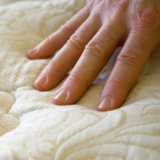Organic Latex Mattress
Are These the Best Latex Foam Mattresses?
How can you benefit from sleeping on an organic latex mattress? Is a natural latex mattress the same as an organic one? Discover why latex foam mattresses are giving memory foam mattresses some competition in the mattress market these days!
Latex mattresses are resilient, durable, and extremely comfortable. The differences between natural and synthetic latex mattresses do make a significant difference for many consumers.
We'll take a look at the process by which natural and synthetic latex is processed, the advantages and disadvantages of using an organic latex mattress, why it's best to choose natural and organic over a synthetic version, and some tips for choosing the healthiest and most comfortable one.
How is Natural Latex Processed?
The latex serum is collected from rubber trees located near the equator. The serum will naturally coagulate unless a small amount of ammonia is added to the serum until it's time for processing. The ammonia does wash out during the processing of the latex serum.
Natural latex is produced by one of two methods: the Dunlop method or the Talalay method. The Dunlop method is the oldest and more traditional method of processing natural latex, whereas the Talalay method is somewhat new to the industry.
Both methods begin the same way - the latex is filtered so that unnecessary particulates can be removed. Next, the latex is processed using air bubbles and water. The last stage is a slow heating and vulcanization process. It's during this last stage that the natural latex is formed into a solid state that can be used for making mattresses.
The difference in the Talalay method is that prior to heating the latex, the entire mixture is flash frozen and then heated very quickly to turn the liquid latex into a solid form.
What is the difference? You can feel the difference in the firmness of the mattress. Mattresses with latex manufactured with the Dunlop method are firmer whereas mattresses manufactured using the Talalay method are softer and less firm.
Natural vs. Synthetic Latex
Natural latex is 90-95% all natural material following processing. Yes, there are a few chemicals used in the processing - fatty acid soaps, sodium, zinc oxide, and sulfur - but these must be used in order to bring the natural liquid latex to a solid form that can be used for mattresses. The good news is that the majority of those few chemicals are washed away following the processing stage so that any residue left behind from these chemicals are removed.
Synthetic latex begins with natural latex serum, but during the processing of the liquid latex into a solid form, a variety of chemicals are added to the mix. Manufacturers of synthetic latex say that their process creates a latex mattress that is more durable, denser, and more comfortable. The downside is that the chemicals leave behind residual odors that can cause allergic reactions for some consumers.
What Makes a Latex Mattress Organic?
You'll see a lot of marketing hype surrounding the organic and natural mattresses on the market, but there is simply one thing you need to know about organic latex mattress.
What makes a Natural Latex Mattress Organic?
The latex from which your mattress is manufactured cannot be stamped as an organic product despite the fact that the serum from the rubber tree is an all-natural product. When you see the term organic used in reference to latex mattresses, that term refers to all the other components that make up your mattress, not the latex itself.
A latex mattress can be called organic as long as no sand fillers were used in the design of the mattress, that no synthetic materials were used to manufacture the cover of the mattress, and that no flame retardant chemicals were sprayed onto the mattress. Organic wool is naturally flame retardant and when thick enough and compressed enough, can serve in the place of the chemicals used in other mattresses.
Be forewarned, not all natural latex mattresses are organic, so be sure to look at the additional components that make up the mattress to determine if those are organically derived.
Benefits of an Organic Latex Mattress
- No chemicals off gassing into your breathing air or into your body
- A green or sustainable mattress option
- All natural materials used to create the components of the mattress
- Latex offers durability and elasticity
- Hypoallergenic
- Doesn't hold onto body odors
- Resists dust mite infestations, mold, and bacteria
- Comfortable for people with pain issues or those who struggle with insomnia
- Conforms to your body without a sinking feeling
- Dense enough to be firm and supportive, but very comfortable
- Keeps you warm in winter and cool in summer
Drawbacks of an Organic Latex Mattress
- The price point on these mattresses can be cost prohibitive for some consumers
- A rigid foundation is required to maximize the comfort of a latex mattress
How to Choose the Best One
- Look for mattresses with 100% natural latex as opposed to synthetic latex
- Simple designs are best - that way you're not dealing with a lot of shifting pieces
- Choose one that features a breathable mattress covering, such as wool blend
- Look for one that has individually covered layers - better protection for your mattress and easier to move
- The warranty should be at least 10 years
- Ask about a trial period - most reputable dealers will offer 60 to 90 days trial
- Inquire about free items - some companies will offer free pillows or accessories with purchase
- Most importantly - purchase from a reputable company with plenty of independent third party reviews - or else you could find yourself with a mattress you don't want and no refund from the company
- Check the return policy carefully - some mattress companies will give you credit, but not cash back, which means you will be forced to spend your credit with them rather than getting cash back to go anywhere you like to shop for a new mattress
Why Is Organic Latex The Best Choice for Chemically Sensitive People?
Anyone who suffers with chemical sensitivity can tell when there are chemicals in the room or in the vicinity because they usually react quickly with an oncoming headache or migraine, watering eyes, or even a sore throat. It doesn't take long for them to react!
Organic latex bedding is the best choice for anyone who suffers with chemcial sensitivity and for those who suffer with allergies because the organic latex contains no toxic chemicals or synthetic ingredients. Latex naturally repels allergens and critters, so allergic reactions are pretty much 'nil. Either way, it's a great idea to go with the organic version of a latex mattress so you can sleep better at night and enjoy a healthier, cleaner sleeping environment!
More Tips for Buying an Organic Latex Mattress
The foundation for an organic latex mattress should be very supportive given the weight of a latex mattress. The slats for a latex mattress foundation should be spaced roughly 2 inches apart, but no more. Also, make sure the cover of your foundation is an organically produced cover, not synthetic.
Let's All Sleep Better
Help us to spread the word!
Simply copy and paste this code into your Facebook page or blog. Thank you for sharing!
Related Articles:



New! Comments
Share your thoughts about what you just read! Leave me a comment in the box below.